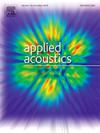Stationary wavelet Filtering Cepstral coefficients (SWFCC) for robust speaker identification
IF 3.4
2区 物理与天体物理
Q1 ACOUSTICS
引用次数: 0
Abstract
Extracting robust effective speech features is one of the challenging topics in the speaker recognition field, especially in noisy conditions. It can substantially improve the robustness recognition accuracy of persons from their voice signals against such conditions. This paper proposes a new feature extraction approach called Stationary Wavelet Filtering Cepstral Coefficients (SWFCC) for noisy speaker recognition. The proposed approach incorporates a Stationary Wavelet Filterbank (SWF) and an Implicit Wiener Filtering (IWF) technique. The SWF is based on the stationary wavelet packet transform, which is a shift-invariant transform. The performance of the proposed SWFCC approach is evaluated on the TIMIT dataset in the presence of different types of environmental noise, which are taken from the Aurora dataset. Our experimental results using the Gaussian Mixture Model-Universal Background Model (GMM-UBM) as a classifier show that SWFCC outperforms various feature extraction techniques like MFCC, PNCC, and GFCC in terms of recognition accuracy.
求助全文
约1分钟内获得全文
求助全文
来源期刊

Applied Acoustics
物理-声学
CiteScore
7.40
自引率
11.80%
发文量
618
审稿时长
7.5 months
期刊介绍:
Since its launch in 1968, Applied Acoustics has been publishing high quality research papers providing state-of-the-art coverage of research findings for engineers and scientists involved in applications of acoustics in the widest sense.
Applied Acoustics looks not only at recent developments in the understanding of acoustics but also at ways of exploiting that understanding. The Journal aims to encourage the exchange of practical experience through publication and in so doing creates a fund of technological information that can be used for solving related problems. The presentation of information in graphical or tabular form is especially encouraged. If a report of a mathematical development is a necessary part of a paper it is important to ensure that it is there only as an integral part of a practical solution to a problem and is supported by data. Applied Acoustics encourages the exchange of practical experience in the following ways: • Complete Papers • Short Technical Notes • Review Articles; and thereby provides a wealth of technological information that can be used to solve related problems.
Manuscripts that address all fields of applications of acoustics ranging from medicine and NDT to the environment and buildings are welcome.
 求助内容:
求助内容: 应助结果提醒方式:
应助结果提醒方式:


